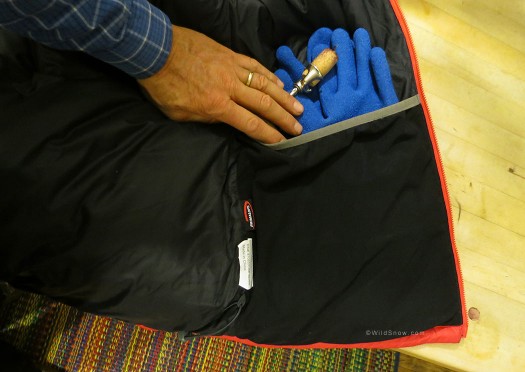
OR Chaos 2013-14
Every mountain man needs a burly synthetic parka. This is your go-to if you’re a regular in maritime climates. Even in sunny dry Colorado I find myself wanting a thick synthetic jacket now and then. Say, for rainy trailheads, as an over-layer during pre dawn starts (throw in the car just before starting up), or just my knock-around parka that won’t spew feathers like a tennis serve machine if I happen to get a fingernail sized fabric tear while modifying expensive new ski boots.
(Oh, and when the big synthetic puffy wears out and looks too crummy for photos, perfect for logging and other mountain hombre type activities up at WildSnow Field HQ.)
Original Chaos was a good thing. Thick synthetic under a Gore Windstopper shell that repelled all but the most torrential moisture yet breathed easily. But the original Chaos fit rather loosely, and could have been slightly thicker. (Note, current OR Havoc jacket has WindStopper shell, is a trimmer and lighter weight synthetic worth considering — could be a favorite. See links at bottom of post.)
Version 2.0 of the Chaos maps 170g PrimaLoft on the torso and arms, 133g in the hood. Believe me, that is thick and warm. I’m wearing this walking sleeping bag at my desk as I type these words. I’m one tenth of a degree from heat stroke. And yes, I’ve been using the jacket outdoors as well.
To compensate for the added fill weight, thin Pertex fabric is used for the shell. In my opinion that’s what all synthetic jacket builds should do — use lighter fabric because down-proofness is not an issue. Only question is why they didn’t just use the thinnest fabric both inside and out (inside is thinner). The logic of this mix in materials escapes me. How much you want to bet it’s so the jacket looks better on the rack (or perhaps is necessary so the DWR treatment is more than psychological)? Whatever the case, consider this a prod for making synthetic jackets as minimalist as possible.
Chaos jacket feature pros and cons:
– Drop-in pockets! I’ve noticed more of these appearing in outdoor apparel since we detailed them during our Denali get-ready back in 2010. Hopefully we spurred the designers. All jackets should have drop-ins. Period. But why not left and right? Only drop-in on this jacket is on left side.
– Bonus! Drop-in pocket makes the perfect stow pocket for the Chaos jacket. You can reverse the pocket and stuff the parka in seconds without extreme compression that’s bad for synthetic fill. Indeed, a commodious drop-in pocket such as this is a feature all jackets should have. I guess we’ll have to start sewing them in again.

Mesh drop-in pocket easily reverses and makes quick stowage for the parka. An incredibly nice feature when your hands are too cold for tightly stuffing the jacket.
– No-nonsense side pockets. No zippers. I mean, who when wearing a backpack uses these things, anyway? They’re nice for your hands when you’re walking around Jasper in late December, that’s about it.
– Semi-athletic cut is perfect compromise.
– Sleeve length is perfect for me, but I really don’t need the velcro on the cuffs.
– Two-way zipper is present; mandatory for a “belay” parka.
– One Napolean chest pocket is appreciated, probably don’t need two outside ones on a puff jacket, so they located a smaller one inside. Too small, but it’s there.
– Per the whole industry ramping up their hood performance, Chaos has a nice system that cinches two stretchy fabric inserts on the sides, resulting in a form-fitting feel that moves with our head. The collar comes up perfectly. Everything in the neck and head area works together and gives the impression a designer put some thought into it. Helmet compatible, but tight. If I used a helmet 24/7 I’d want the hood larger with more fabric at the back of my neck.
– Weight of my size large is 26.5 ounces, 752 grams, totally reasonable for what you get.
Or get more athletic with the Outdoor Research Havoc.
WildSnow.com publisher emeritus and founder Lou (Louis Dawson) has a 50+ years career in climbing, backcountry skiing and ski mountaineering. He was the first person in history to ski down all 54 Colorado 14,000-foot peaks, has authored numerous books about about backcountry skiing, and has skied from the summit of Denali in Alaska, North America’s highest mountain.

